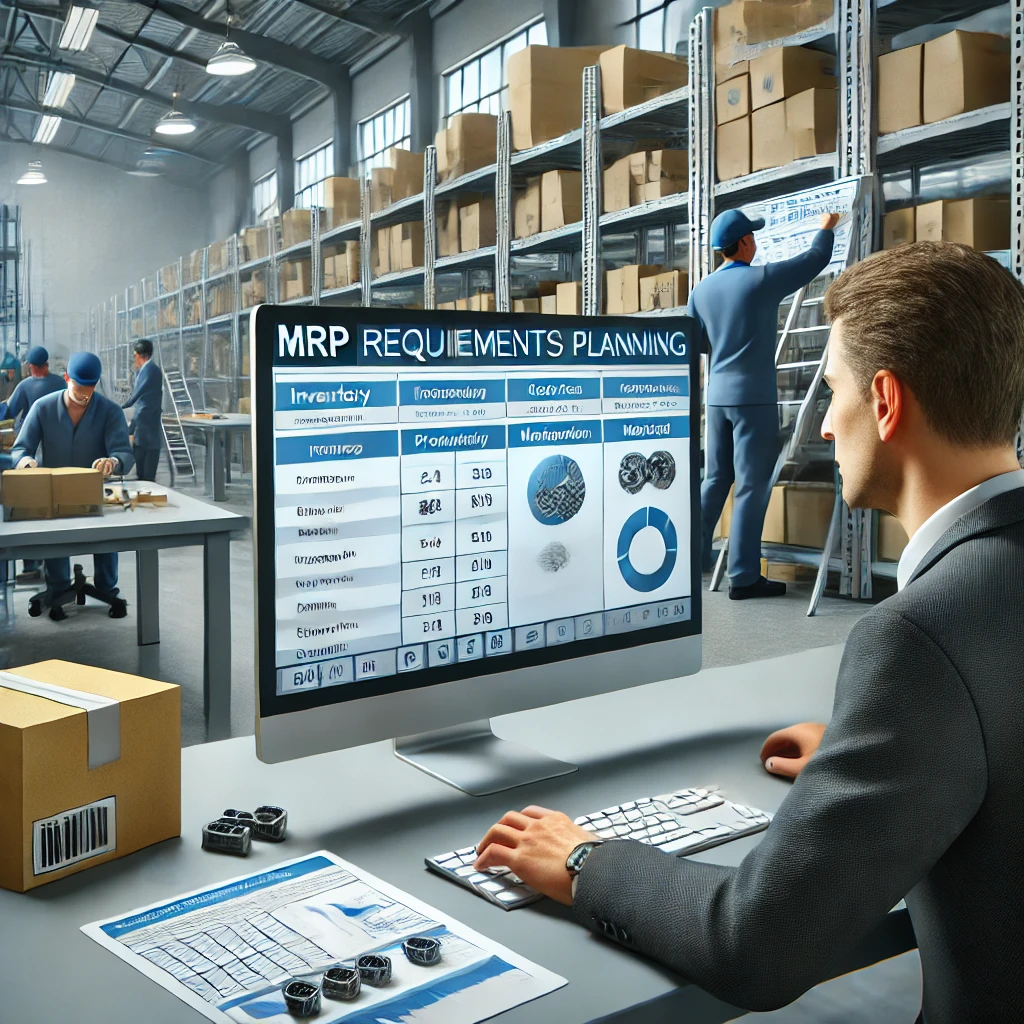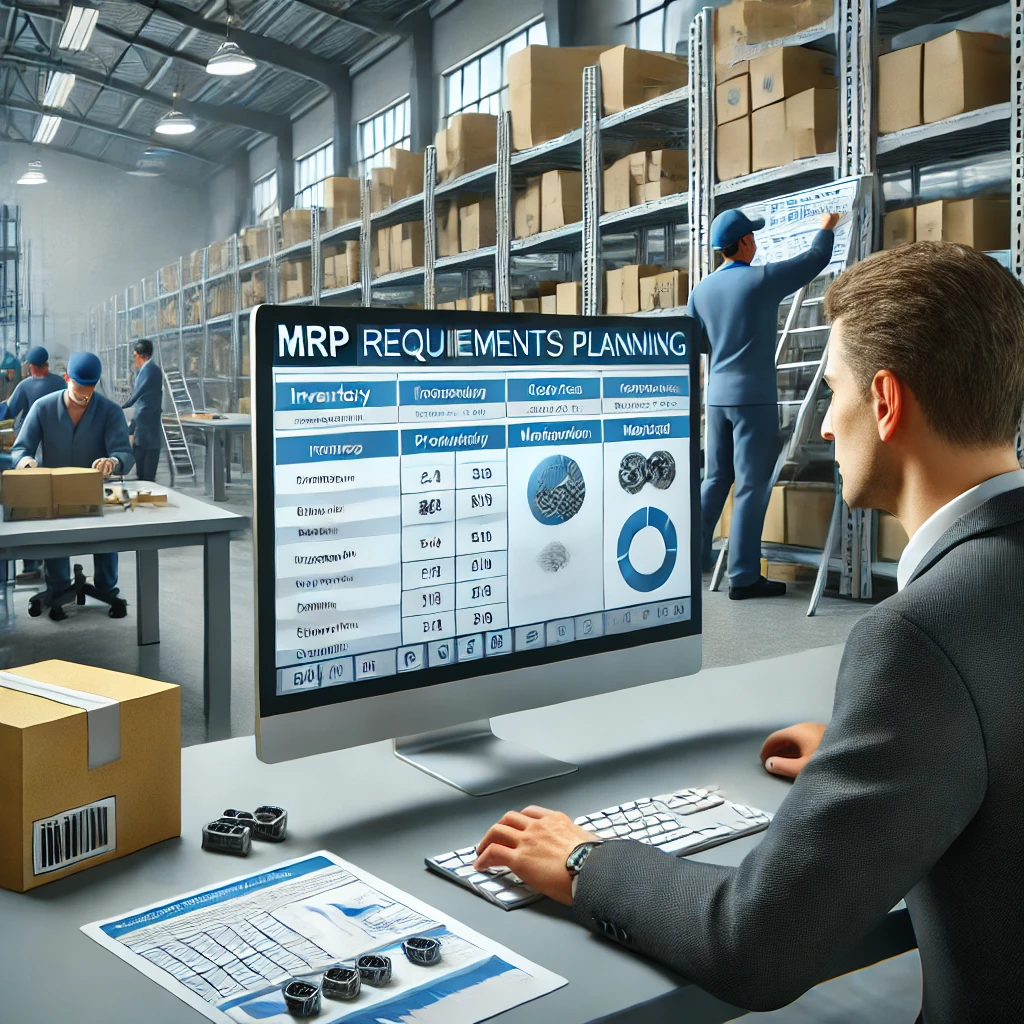Implementing an MRP System: Step-by-Step Guide for Small to Medium Manufacturers

Why Small to Medium Manufacturers Need MRP
Before diving into the implementation process, let’s briefly review why MRP is crucial for smaller manufacturers:
- Improved Inventory Control: Optimize stock levels, reducing carrying costs and stockouts.
- Enhanced Production Planning: Better align production with demand.
- Increased Efficiency: Streamline processes and reduce waste.
- Better Decision Making: Access real-time data for informed choices.
- Scalability: Support growth with a system that can expand with your business.

Step-by-Step Implementation Guide
Step 1: Assess Your Current Processes and Needs
- Evaluate existing workflows and pain points
- Identify key requirements for your MRP system
- Set clear goals for the implementation
Step 2: Secure Management Buy-In and Allocate Resources
- Present the benefits and ROI of MRP implementation
- Secure budget for software, hardware, and training
- Assign a dedicated project team
Step 3: Choose the Right MRP System
- Research available options (cloud-based vs. on-premise)
- Consider scalability and integration capabilities
- Evaluate vendor reputation and support services
- Request demos and trial periods
Step 4: Plan the Implementation
- Develop a detailed project timeline
- Define roles and responsibilities
- Create a risk management plan
- Plan for data migration and system integration
Step 5: Prepare Your Data
- Clean and organize existing data
- Standardize data formats
- Develop a data governance policy
Step 6: Configure the MRP System
- Set up master data (items, BOMs, work centers)
- Configure system parameters
- Customize reports and dashboards
Step 7: Integrate with Existing Systems
- Connect MRP with accounting, CRM, and other relevant systems
- Ensure data flows smoothly between systems
- Test integrations thoroughly
Step 8: Conduct Staff Training
- Provide role-specific training for all users
- Offer hands-on practice sessions
- Create user manuals and quick reference guides
Step 9: Perform a Pilot Run
- Test the system with a small subset of products or a single department
- Identify and resolve any issues
- Gather feedback from users
Step 10: Go Live and Monitor
- Roll out the system across the entire organization
- Closely monitor system performance and user adoption
- Address any issues promptly
Step 11: Continuous Improvement
- Regularly review system performance
- Seek ongoing user feedback
- Implement updates and new features as needed
Best Practices for Successful MRP Implementation
- Start Small: Begin with core functionalities and expand gradually.
- Ensure Data Accuracy: Prioritize data cleansing and maintenance.
- Involve End-Users: Engage users throughout the implementation process.
- Customize Wisely: Adapt the system to your needs, but avoid over-customization.
- Document Everything: Maintain detailed records of configurations and processes.
- Plan for Change Management: Address resistance to change proactively.
- Leverage Vendor Support: Utilize available training and support resources.

Common Challenges and Solutions
- Challenge: Limited budget Solution: Consider cloud-based solutions with lower upfront costs
- Challenge: Resistance to change Solution: Communicate benefits clearly and involve staff in the process
- Challenge: Data accuracy issues Solution: Invest time in data cleansing and implement data governance policies
- Challenge: Integration with legacy systems Solution: Choose an MRP system with robust integration capabilities or consider middleware solutions
- Challenge: Limited IT resources Solution: Opt for user-friendly systems or consider managed services

Measuring Success
To ensure your MRP implementation is delivering value, track these key performance indicators (KPIs):
- Inventory turnover rate
- Production lead times
- On-time delivery rates
- Stockout frequency
- Overall equipment effectiveness (OEE)
- Cost of goods sold (COGS)

Conclusion
Implementing an MRP system is a significant undertaking for small to medium manufacturers, but the benefits far outweigh the challenges. By following this step-by-step guide and adhering to best practices, you can successfully integrate MRP into your operations, leading to improved efficiency, better resource management, and increased competitiveness.
Remember, MRP implementation is not a one-time event but an ongoing process of optimization and improvement. Stay committed to refining your processes and leveraging new features to ensure your MRP system continues to deliver value as your business grows and evolves.
How Linbis Can Help
At Linbis, we understand the unique challenges that small to medium manufacturers face when implementing MRP systems. Our expertise in logistics and manufacturing software development allows us to offer tailored MRP solutions that address the specific needs of smaller operations while providing room for growth.
Here’s how Linbis can assist your business in implementing an MRP system:
- Customized Solutions: We develop MRP systems that fit your exact needs and budget, ensuring you get all the necessary functionality without paying for features you won’t use.
- Scalable Architecture: Our MRP solutions are designed to grow with your business, allowing you to add features and capacity as needed.
- User-Friendly Interfaces: We create intuitive interfaces that minimize the learning curve, crucial for smaller teams with limited training resources.
- Seamless Integration: Our team ensures smooth integration between your new MRP system and existing software, preserving your prior investments.
- Data Migration and Cleansing: We help you transfer and clean your existing data, ensuring a smooth transition to the new system.
- Phased Implementation: We can structure the implementation in phases, allowing you to manage costs and minimize disruption to your operations.
- Comprehensive Training: Linbis offers tailored training programs to ensure your team can effectively use and maintain the MRP system.
- Ongoing Support: We provide continued support and maintenance, acting as an extension of your IT team.
- Cost-Effective Solutions: Our expertise in cloud technologies allows us to offer robust, yet affordable MRP solutions suitable for smaller budgets.
- Industry-Specific Customization: We understand that different manufacturing sectors have unique needs, and we tailor our MRP solutions accordingly.
By partnering with Linbis, you’re not just getting an MRP system – you’re gaining a technology partner committed to your success. Our team of experts can guide you through every step of the implementation process, ensuring that your MRP system delivers maximum value to your business.
Remember, while Linbis provides the technological expertise, the success of your MRP implementation ultimately depends on how well it’s integrated into your business processes. Let Linbis be your guide in leveraging this powerful technology to streamline your operations, improve efficiency, and drive your manufacturing business forward, no matter your size or sector.
